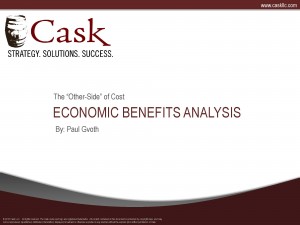In my last post on March 5, 2014, I discussed the differences and similarities between Cost Estimation/Analysis and Economic Benefits Analysis. Further, I introduced the concept of Capabilities Based Benefits Analysis (CBBA) and how estimating the economic and non-economic benefits of a program, project, or other investment presents its own challenges in contrast to those facing the cost estimator. Ok, so this all sounds great, but where do I start? Let's set out some assumptions that will underpin our analysis:
- Investment Provides Capabilities which Generate Benefits
- Return on Investment (ROI) is negative in the beginning due to massive initial investment outlay for development and implementation
- ROI improves as the system increasingly provides capabilities and generates monetary benefits as well as intangible benefits
- End Game: More Benefits than Cost
Shown in the illustration below; in the beginning of a project or acquisition the initial financial outlays typically outweigh expected financial benefits resulting in a negative Return on Investment (ROI). As capability is built and refined it leads to the achievement of operational efficiencies, which in due time will save money. The specified savings and other positive subjective attributes create the total sum of economic benefits that will be used to determine the projects ROI. If not, then the project should be a candidate for cancellation - unless there are qualitative benefits that outweigh the importance of a financial ROI.
Let's say that you have been driving around in your Grandpa's old clunker car. He's no longer driving and now it's yours. It gets you to work (or school) and back, but that's about all it does. In addition, it doesn't impress anyone and your friends won't ride with you because of their own concern for safety. You have thought about getting a new car or a good used one (oxymoron?). However, making that big investment decision will require a thorough analysis of the net Economic Benefits of a new or newer car relative to keeping the "clunker". We need to examine what cost savings and other benefits may be generated if and when we move to a new alternative that provides at least the same, or enhanced capability of getting you from point "A" to point "B". Notice that I said "we", because you have now brought me into the decision process as your trusted consultant and analyst. Your investment cost for the "clunker" was zero. It was a gift - or was it really? There is no warranty. It requires regular tune-ups, and it's a large car that you drive daily in heavy commuting traffic over long distances causing expensive brake replacements three times per year. Parts are also hard to find and are expensive - but hey it was "free". These are Maintenance Costs and upgrading to a newer model car will immediately generate our first economic benefit - "Direct Cost Savings" because those recurring maintenance costs will go away. These are the easiest to calculate and are the most directly understood. Often enough savings are generated that further analysis into additional economic benefit is not needed. We are going to gather-up the total amount of money we spent on maintenance over the past year and set that aside for now. In addition to all the maintenance costs, we also know that this old car is a gas hog. A newer car will immediately improve our Operational Efficiency (OE) and provide a second tier benefit - "Cost Avoidance". We will calculate what we spent on gas in the clunker over the past year and what we estimate the newer car's gas cost will be in the coming year. Assuming the newer car will use less gas, we can claim the difference as a cost avoidance economic benefit. It's cost avoidance because if you don't make the move to another car that is fuel efficient, you are guaranteed to have higher fuel costs in the coming year, which can be avoided by purchasing a newer car. In addition, we know that the transmission will most likely be replaced in the next year costing about $3k. If you get rid of the old car, that cost avoidance can be captured and added as a monetary benefit to the other savings. There are many other cost avoidances to consider, but these will do for now. Finally, we have to think about capturing "Qualitative Benefits". Oh yeah, you are going to be looking pretty good behind the wheel of that newer car, and your friends will feel better about joining you since the safety of the car has gone way up. To assess these qualitative benefits, we could use a variety of Decision Analysis tools to help put a value on the subjective attributes and determine, if in fact, they outweigh the expected economic benefits (I want that car and I don't care what it costs me - until later). Combining the quantitativefinancial data with the qualitative value data, in addition to other quantitative Key Performance Indicators (KPI) will help us not only decide if it is worth getting a better vehicle, but also helps us choose among the many available alternatives at each price point. How to do this is reserved for another blog. Right now we just want to make sure that if we spend money on enhanced transportation capability (new wheels!), that the qualitative and quantitative benefits justify the cost in terms of ROI vs. other ways we could spend the same amount of money. This car example is trivial, but it shows the thought process of how one would go about building an economic benefits framework, and then populate it with data. In practice, Major Automated Information Systems (MAIS), as well as other projects, require a large up-front investment and undergo a long development phase before even the first benefit can be realized. For this reason, economic benefits must accrue over a very long time to hit break-even, let alone show a positive ROI. That's why qualitative benefits sometimes play a bigger role due to the added capability applied to everyday business processes ranging from ordering supplies to actual warfighting. Next time I will wrap up this discussion by showing how these economic benefits can be tied directly to investments in capability through the creation of the Performance Improvement Metrics Table (PIMT) and its importance to the Benefit/Cost analysis. I will also discuss how you can show a positive ROI for a project where there are no financial benefits - just increased capability and value to stakeholders. This is very important. For example, some IT projects produce huge strategic capabilities but it's difficult to tie them directly to a financial bottom-line, even though they are extremely valuable to the business. See you in a few weeks.






